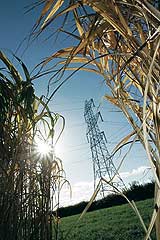UK's largest coal power plant invests £50 million to cut down carbon pollution
20 May 2008
 In a move aimed at cutting carbon emmisiions, the UK's largest power station, Drax, has em,barked on a £50-million project to cut down its coal consumption by replacing 10 per cent of its coal requirement with biomass, which will be prepared at a processing plant to be built by French power equipment major Alstom. The first part of the facility is expected to be completed by the end of 2009.
In a move aimed at cutting carbon emmisiions, the UK's largest power station, Drax, has em,barked on a £50-million project to cut down its coal consumption by replacing 10 per cent of its coal requirement with biomass, which will be prepared at a processing plant to be built by French power equipment major Alstom. The first part of the facility is expected to be completed by the end of 2009.
Alstom's 1.5-million tonnes per year biomass co-firing facility will be constructed at the 4,000MW DraxPower Station in North Yorkshire, believed to be the largest biomass cofiring project in the world, and is a part of Drax's target of reducing its carbon dioxide emissions by 15 per cent, based on current out put by 2011. Mixing materials such as wood chips, husk or grass with coal to generate electricity could reduce the power station's annual carbon dioxide emissions from coal by several million tonnes.
1.5-million tonnes of biomass feedstock would yield the same energy output as using 1 million tonnes of coal. Finely powdered biomass will be injected directly into the power station's coal-fired furnaces. Since biomass is cosidered as being carbon neutral, any CO2 it produces does not count towards the power station's total emissions, enabling the power firm claim a reduction in CO2 emissions by mixing biomass into its furnaces.
Drax produces 7 per cent of the UK's electricity that is generated at its coal-fired power plant trhat emit at 4 per cent of the UK's total greenhouse gas emissions of CO2, making it one of Europe's top five sources of gas pollution.
Drax says co-firing, the blending and burning of renewable biomass materials with coal is a recognised carbon abatement technology that has significant potential to reduce the emissions of CO2 from coal-fired power stations. It says that over the last five years, the power firm has developed the capability to co-fire renewable biomass materials with coal and has set a target of producing 10 per cent of its output from co-firing, the equivalent output of around 500 wind turbines, which will reduce its emissions of CO2 by over two million tonnes each year.
If co-firing coal with biomass proves successful, teh company says it would consider increasing the proportion of plant material it adds to its fuel mix, even doubling it.
Drax says it is also making good progress with its turbine upgrade project, which when complete will deliver a further one million tonnes saving in CO2 emissions.
"Meeting our 10 per cent co-firing target is key to achieving our goal of 15 per cent carbon abatement and this contract represents a major milestone in the execution of our co-firing project," said Dorothy Thompson, chief executive of Drax. ''We have a role to play in the transition towards a low carbon economy whilst delivering reliable supplies of electricity.''






























